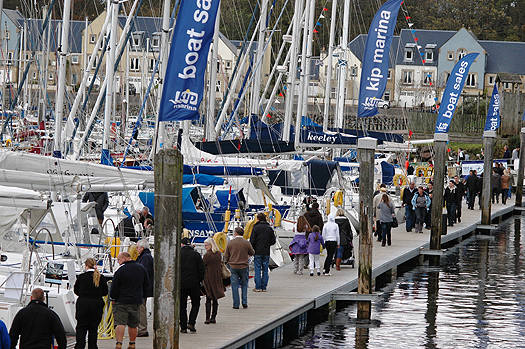Displaying items by tag: KIp
25th Scottish Show Claims Bumper Crop of Irish Visitors
Opening its gates at 10am last Friday and the first boat being sold just 10 minutes later. Organisers confirmed to Afloat.ie that the numbers of visitors from both Ireland - north and south - was up on previous years. The buoyant feed back is a fillip for the marine leisure indsutry here and in the UK.

A busy pontoon during the show
The records continued to fall from there on with first day attendances more than double the previous year – a statistic which was to repeat throughout the show - ending up with a massive 12,000 visitors more than any previous show and bucking the trend elsewhere for declining visitor numbers at boat shows.
Scotland's Boat Show 2011 attracted visitors from all over Scotland, the North & South of England, Ireland and even from Europe but none could compare with the couple who arrived from New Zealand having added the show to their European itinerary after reading about it on the internet! They even had a chance to watch their beloved All Blacks play courtesy of Boat Electrics who were demonstrating satellite TV systems!
Throughout the show as the thousands of visitors flocked to Kip Marina to view the best and brightest of the boating world, it became apparent that exhibitors were also enjoying a bumper weekend – the Directors of Inspiration Marine who sell Hanse, Dehler and Moody yachts said "This is better than Southampton! We have done more business here in three days than we did in 10 days on the South Coast"
Prosser Marine MD Stan Prosser said "The 2011 Scotland's Boat Show has proved beyond doubt that if you are in the boating business anywhere, you need to be in Scotland every October!"
Boat sales during the show totalled an incredible £1.3m and, with many dealers having a diary full of viewings still to come, that figure will rise steeply over the coming weeks.
Scotland's Boat Show was officially opened by Education Secretary Mike Russell MSP who said of the shows 25th Anniversary, "Twenty-five years is a long time and the show has gone from strength to strength. What is really important is the strong impact it has on the local economy. We are talking about very serious money being spent here this weekend.
Kip Marina's Managing Director Gavin McDonagh said "With possibly the busiest day in Kip Marina's 40 year history, it is proof that the show has become the premier boat show in the North of the UK. We are delighted that all the exhibitors who have made the journey straight here from Southampton Boat Show had such a rewarding show and look forward to welcoming many more next year!
With so many attractions at this year's show – over 150 boats for sale, from a £500 dinghy to a half a million pound luxury motor yacht, more than 30 marine trade companies from all over the UK exhibiting the latest trends and products in the world of boats plus the chance to see 'Quantum of Solace' the 43' Sunseeker Superhawk powerboat from the James Bond film of the same name, a full range of Aston Martin and Rolls Royce motor cars together with the limited edition Volvo Ocean Racer 4x4's.
























































